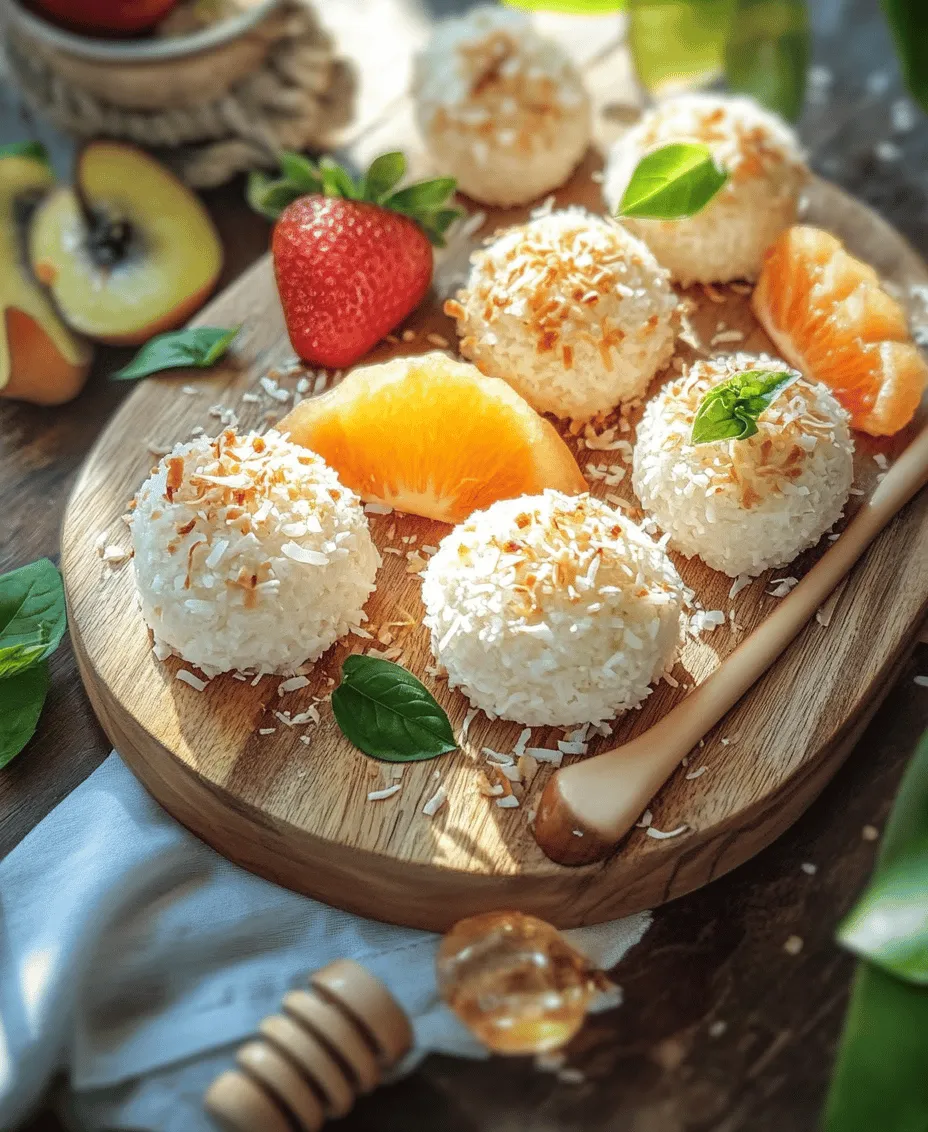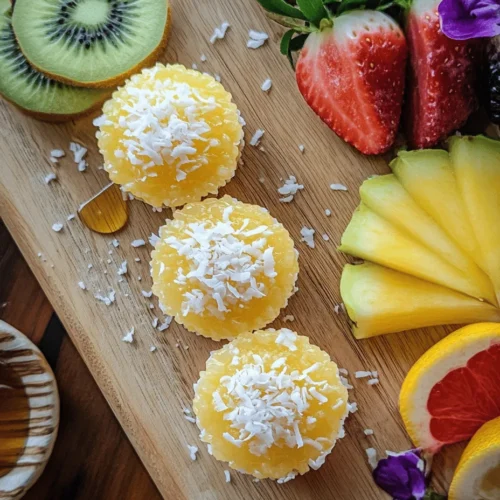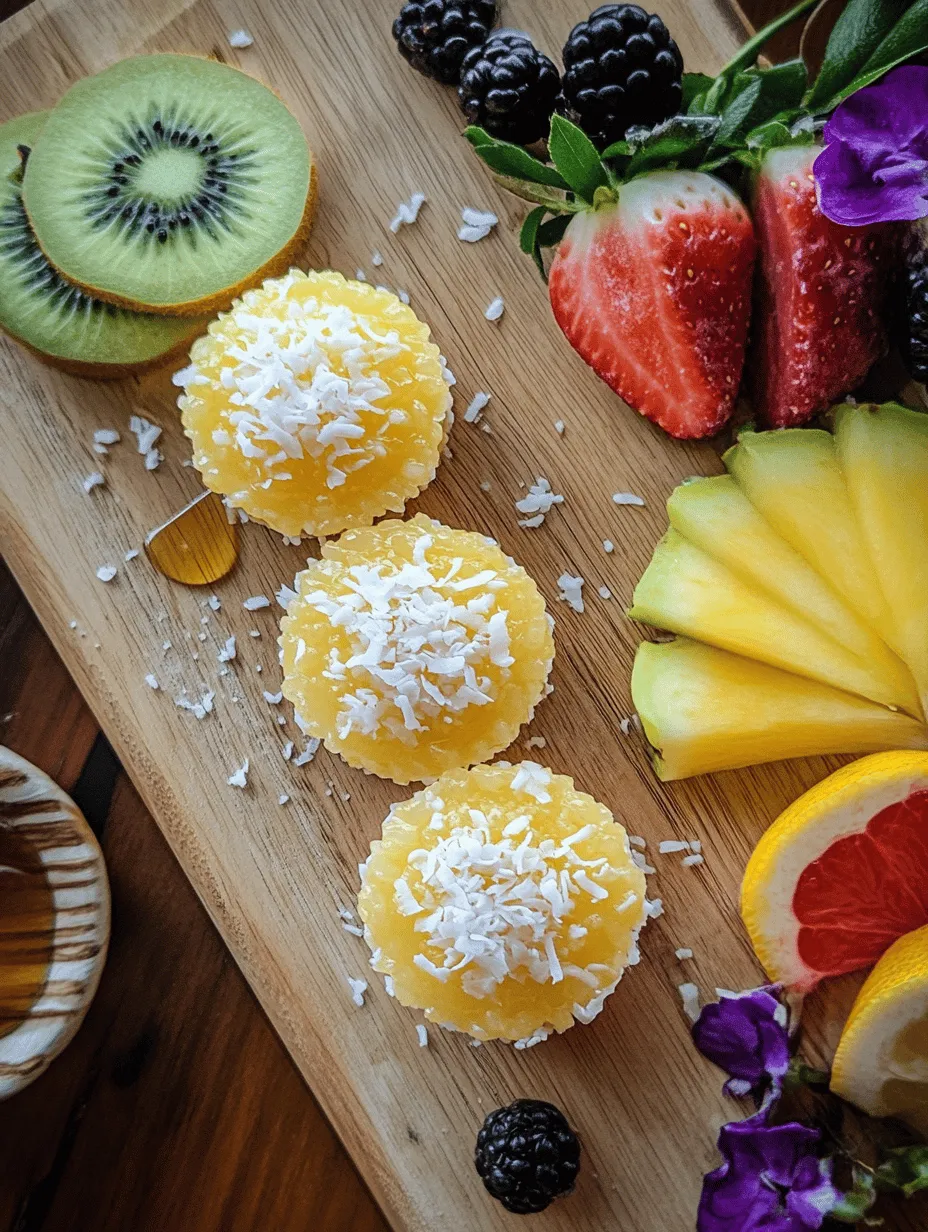Introduction
Coconut rice cakes are an enchanting delicacy that combines the rich, creamy flavor of coconut with the delightful texture of rice. This combination results in a dessert that not only pleases the palate but also evokes a sense of tropical bliss. As the world becomes more enamored with coconut-based desserts, these rice cakes stand out for their versatility. Whether served as a delightful snack or a sweet treat at a gathering, coconut rice cakes are sure to impress.
Coconut flavors are celebrated across various cultures, from Southeast Asia to the Caribbean, where they play a pivotal role in traditional desserts. The allure of coconut lies in its ability to evoke memories of sun-soaked beaches and lush tropical landscapes, making it a favorite ingredient in many culinary traditions. The creamy texture of coconut milk, paired with the soft chewiness of rice, creates a balance that is both comforting and indulgent.
As we delve deeper into the world of coconut rice cakes, you will discover their multifaceted nature, perfect for any occasion, from casual family snacks to elegant dinner parties.
The Allure of Coconut in Cooking
Coconut has become a star ingredient in global cuisine, and its popularity is no surprise. This versatile fruit can be used in various forms—milk, flour, oil, and shredded pieces—each contributing unique characteristics to dishes. The creamy richness of coconut milk provides a luscious base for soups and desserts, while shredded coconut adds a delightful chewiness to baked goods. Coconuts are a staple in tropical regions, where they are often harvested fresh, infusing local dishes with vibrant flavors.
In addition to its culinary appeal, coconut is also renowned for its nutritional benefits. Coconut milk is a rich source of healthy fats, particularly medium-chain triglycerides (MCTs), which are easily digestible and may support heart health and weight management. Shredded coconut, whether sweetened or unsweetened, is high in dietary fiber and can contribute to a feeling of fullness. This makes coconut an excellent choice for those seeking satisfying snacks that also offer nutritional value.
The marriage of coconut and rice is a match made in culinary heaven. Rice, being a neutral and versatile grain, serves as the perfect canvas for the creamy, tropical notes of coconut milk. When combined, they create a harmonious texture and flavor profile, resulting in rice cakes that are both delectable and satisfying. The rice’s natural starches help bind the ingredients together, ensuring a delightful chew with every bite.
Ingredients Breakdown
To craft the perfect coconut rice cakes, it’s essential to understand the role of each ingredient. Here’s a detailed breakdown of what you’ll need:
Jasmine Rice
Jasmine rice is the preferred choice for coconut rice cakes due to its fragrant aroma and slightly sticky texture. This long-grain rice, native to Thailand, has a subtle floral scent that complements the coconut flavor beautifully. When cooked, jasmine rice becomes tender and slightly sticky, making it ideal for molding into cakes.
Coconut Milk
Coconut milk is the star ingredient in this recipe, providing the rich, creamy base that defines the rice cakes. It’s important to distinguish between coconut milk and regular dairy milk; coconut milk is made by extracting the liquid from grated coconut meat and is known for its distinctive flavor and creamy texture. This milk not only enhances the taste of the rice cakes but also contributes to their moistness. When selecting coconut milk, look for full-fat versions for the creamiest results, but light coconut milk can be a suitable alternative for those watching their fat intake.
Sugar
Sugar acts as the sweetener in coconut rice cakes, enhancing their flavor and providing a pleasant contrast to the coconut’s natural richness. You can choose from various types of sugar, including granulated white sugar, brown sugar, or even coconut sugar for a more caramel-like flavor. For those with dietary restrictions, alternatives such as agave nectar, maple syrup, or stevia can be used, though adjustments may be needed to achieve the desired consistency.
Shredded Coconut
Shredded coconut adds both texture and flavor to the rice cakes. You can use either sweetened or unsweetened shredded coconut, depending on your preference and dietary needs. Sweetened shredded coconut is typically coated in sugar, giving a more pronounced sweetness, while unsweetened coconut allows the natural flavor of the coconut to shine through. Both types can enhance the overall taste and presentation of your rice cakes.
Vanilla Extract
Vanilla extract is a simple yet effective way to elevate the flavor profile of your coconut rice cakes. The warm, sweet notes of vanilla complement the coconut’s tropical essence, creating a more complex and satisfying taste. For the best results, opt for pure vanilla extract rather than imitation, as it has a more pronounced flavor.
Baking Powder
Baking powder is a crucial ingredient in this recipe, providing the leavening needed to give the rice cakes a light and airy texture. It helps create a slightly puffed effect, making the cakes tender and easy to bite into. Ensure that your baking powder is fresh for optimal results, as expired baking powder may not provide the necessary lift.
Optional Toppings
To enhance the taste and presentation of your coconut rice cakes, consider adding optional toppings. Fresh fruit, such as mango slices or berries, can add a burst of color and freshness. A drizzle of honey or maple syrup can also enhance sweetness, while a sprinkle of toasted nuts or seeds can provide a satisfying crunch. For a truly tropical experience, consider garnishing with additional shredded coconut or a dusting of powdered sugar.
Step-by-Step Instructions for Coconut Rice Cakes
Cooking the Rice
The first step in creating these delightful coconut rice cakes is cooking the rice properly. Rinsing the rice is a critical step that should not be overlooked. Begin by placing the jasmine rice in a fine-mesh sieve and rinsing it under cold running water. This process helps remove excess starch, which can make the rice overly sticky and gummy when cooked. Rinsing will give you a better texture in your final cakes.
Once rinsed, transfer the rice to a pot and add water. The general rule is to use a 1:1 ratio of rice to water. This means that for every cup of rice, you’ll need one cup of water. Place the pot over medium heat and bring the mixture to a gentle boil. Once boiling, reduce the heat to low, cover the pot with a lid, and let it simmer for about 15-20 minutes, or until all the water is absorbed and the rice is tender.
After cooking, remove the pot from the heat and let it sit covered for an additional 10 minutes. This resting period allows the rice to steam a bit longer, ensuring it is fully cooked and fluffy. Once the time is up, use a fork to fluff the rice gently, allowing any remaining steam to escape.
As you prepare the rice, you can also gather and measure the remaining ingredients, ensuring everything is ready for the next steps in creating your coconut rice cakes. The combination of perfectly cooked jasmine rice and creamy coconut milk will set the foundation for a truly delightful treat.
By following these steps and understanding the ingredients, you are well on your way to creating coconut rice cakes that are not only delicious but also a celebration of tropical flavors. Stay tuned for the next part, where we will guide you through the mixing process and baking instructions that will bring your coconut rice cakes to life.

Preparing the Mixture
To achieve the right consistency for your Coconut Rice Cakes, each component plays a crucial role. Begin with freshly cooked rice, preferably glutinous or sticky rice, which provides the necessary texture. This type of rice has a higher starch content, allowing it to clump together when cooked, making it ideal for molding into cakes.
Next, incorporate coconut milk into the mixture. The rich creaminess of coconut milk not only enhances the flavor but also adds moisture, which is essential for binding the rice together. If you prefer a lighter version, you can mix coconut milk with water, but keep in mind that this will dilute the coconut flavor slightly.
For sweetness, add sugar or an alternative sweetener. Traditional recipes often use palm sugar, which gives a caramel-like flavor, but granulated sugar or coconut sugar works just as well. Ensure that the sugar is fully dissolved into the warm rice for an even distribution of sweetness.
Lastly, a pinch of salt is necessary to balance the flavors and enhance the overall taste of the cakes. It’s this combination of salty, sweet, and creamy that makes the Coconut Rice Cakes truly delightful.
Shaping the Cakes
Once your mixture is ready, it’s time to shape the coconut rice cakes. The key to achieving optimal texture lies in compacting the rice mixture firmly into molds. Choose a mold that suits your preference—this could be a traditional round cake mold, muffin tins, or even small cups.
Scoop the rice mixture into your chosen mold, filling each one about three-quarters full to allow room for expansion. Using the back of a spoon or your fingers (dampened to prevent sticking), press down firmly to compact the mixture. This step is vital; insufficient compacting will lead to cakes that crumble when removed from the mold. Aim for a uniform thickness, as this will ensure even cooking and consistent texture throughout each cake.
Baking Process
The baking process is where your Coconut Rice Cakes transform into a delightful treat. Preheat your oven to 350°F (175°C). This temperature is ideal for baking rice cakes, allowing them to cook through without burning the outside.
Place your filled molds on a baking sheet for easier handling and to catch any overflow. Bake the cakes for approximately 25-30 minutes. You’ll know they’re ready when the edges start to turn golden brown and the tops look slightly firm and set. A toothpick inserted into the center should come out clean, indicating that the cakes are fully cooked.
Keep an eye on them during the last few minutes of baking. The visual cues—golden edges and a firm top—are essential for preventing over-baking, which can dry out your coconut rice cakes.
Cooling and Serving
Allow your Coconut Rice Cakes to cool in the molds for about 10-15 minutes before transferring them to a wire rack. Cooling is an important step as it helps the cakes firm up, making them easier to handle and enhancing their flavor. If you attempt to remove them too soon, they may break apart.
Once cooled, your coconut rice cakes are ready to be served. Their soft yet firm texture makes them a versatile treat that can be enjoyed in various ways.
Creative Serving Suggestions
To elevate your Coconut Rice Cakes, consider these garnishing ideas:
– Fresh Fruit Slices: Pair your coconut rice cakes with fresh fruit slices like mango, strawberries, or blueberries. The acidity and sweetness of the fruit complement the rich coconut flavor beautifully. A sprinkle of lime juice over the fruit can add an extra zing.
– Drizzle of Honey: A light drizzle of honey or maple syrup can enhance the natural sweetness of the cakes. Honey not only adds a lovely gloss but also brings a floral note that pairs well with coconut. Opt for local honey for added health benefits and a unique flavor profile.
– Additional Shredded Coconut: To amplify the coconut flavor and texture, sprinkle some toasted shredded coconut on top of your cakes before serving. Toasting the coconut brings out its nutty aroma and adds a delightful crunch.
– Presentation Tips: For gatherings or special occasions, serve your coconut rice cakes on a decorative platter. Consider layering them with fruit and garnishes, or even using edible flowers for a pop of color. Individual servings in small cups or lined muffin tins can make for an attractive presentation as well.
Nutritional Information
Each serving of Coconut Rice Cakes (approximately one cake) contains about 150-200 calories, depending on the amount of sugar and coconut milk used. Here’s a basic breakdown of the nutritional values:
– Calories: 180
– Total Fat: 6g
– Saturated Fat: 4g
– Carbohydrates: 30g
– Sugars: 8g
– Protein: 3g
For those with dietary restrictions, this recipe can easily be modified. To make it vegan, simply ensure that the sugar used is vegan-friendly, as some sugars are processed with bone char. For a gluten-free option, stick with glutinous rice and avoid any additives that may contain gluten.
The Cultural Significance of Rice Cakes
Rice cakes hold a significant place in various cultures around the world. In many Asian countries, rice cakes are a traditional food often served during festivals and celebrations. For example, in Korea, rice cakes known as “tteok” are a staple during Lunar New Year celebrations, symbolizing prosperity and good fortune. Similarly, in Japan, “mochi” is enjoyed during the New Year and is associated with health and longevity.
This Coconut Rice Cake recipe can be adapted to reflect different cultural influences by incorporating local flavors. For instance, adding pandan extract can give the cakes a beautiful green hue and a unique flavor reminiscent of Southeast Asian desserts. You can also experiment with spices like cardamom or cinnamon to infuse a warm, aromatic quality.
Conclusion
Coconut Rice Cakes are a simple yet delightful treat that brings together the flavors of coconut and rice in a unique way. The joy of making these cakes lies not only in the process but also in sharing them with family and friends. Whether enjoyed as a snack, a dessert, or a part of a festive meal, these rice cakes are sure to impress.
Encourage your creativity by experimenting with different flavors and toppings, allowing you to personalize your Coconut Rice Cakes to suit your taste. From tropical fruits to various garnishes, the possibilities are endless. Embrace the joy of cooking and the cultural richness that comes with it, and enjoy the delightful experience of making and sharing these coconut rice cakes.



